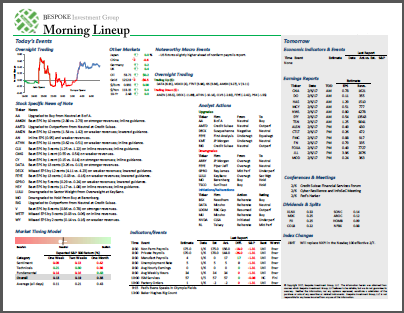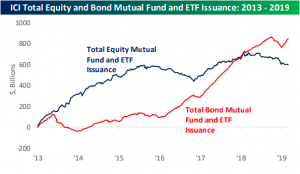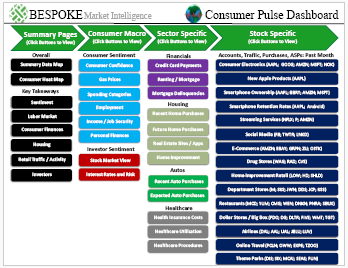ISM Internals Weaker Than Headline
On Wednesday, the Institute for Supply Management (ISM) released its monthly snapshot of US manufacturing in the form of its Purchasing Manager Index. The index reports manufacturers’ activity on a variety of different metrics, creating an overall activity composite for the headline index. In the chart below, we compare the headline index to another series created with two sub-indices of the composite data. Generally speaking, manufacturers report strong activity when new orders are rising faster than inventories. The two series aren’t perfectly correlated, but over time they tend to move together, with the relationship between new orders and inventories typically leading the overall index. As shown in the chart, the New Orders-Inventories spread is at the weakest level since the end of 2012, and is much, much weaker than the headline index. That suggests the recent decline in this measure of manufacturing activity isn’t over yet. Start a two-week free trial to Bespoke Premium to access our interactive economic indicators monitor and much more.
US Equity Guidance: A Proxy For Global Growth
It shouldn’t be a big surprise, but our data shows US corporate management teams are sensitive to global growth. In the chart below, we compare the US equity market’s guidance spread to Markit’s Global Manufacturing PMI. The guidance spread measures the percentage of companies raising guidance each month to the percentage of companies lowering guidance each month. Higher readings indicate more guidance raises relative to lowers, and therefore optimism from management teams about the outlook. We’ve taken the raw monthly percentage, seasonally adjusted it, and taken a 3 month average to compare to ISM. As shown, big upswings or downswings in guidance tend to coincide with similar swings in global manufacturing activity as measured by Markit’s PMI. Currently, we’re in the midst of a swing lower for both, but things are still actually more positive than numerous periods from 2012-2016.
Start a two-week free trial to Bespoke Premium to access our interactive economic indicators monitor and much more.
Bespoke Morning Lineup — Futures Higher Ahead of Jobs Report
The S&P 500 SPY ETF is trading up 37 basis points ahead of the 8:30 AM ET April Employment Report, where nonfarm payrolls are expected to rise by 190,000. Once the report is released, give our jobs preview another look for how stocks and sectors typically trade based on a stronger or weaker than expected outcome.
In today’s Bespoke Morning Lineup, we cover trends for earnings, revenues, and guidance after more than 500 companies reported earnings this week. We also include our regularly updated charts and graphics of market and sector internals that Bespoke subscribers have come to love. If you’re interested in international equity markets and economic data, we’ve got that covered too. This report is all you need to prepare yourself for the trading day ahead. To read today’s Morning Lineup and receive it every trading day going forward, start a two-week free trial to Bespoke Premium.
The Closer — WTI 200-DMA Test, Lowflation, Productivity Puzzle — 5/2/19
Log-in here if you’re a member with access to the Closer.
Looking for deeper insight on markets? In tonight’s Closer sent to Bespoke Institutional clients, we begin with a look at the bearish divergence between the VIX and the S&P 500 as 2-year notes have become increasingly volatile. We also show WTI’s test of its 200-DMA as well as other similar movements in crude throughout the past 20 years. Switching over to macro data, we then show the divergence of core PCE versus other measures. We also look at today’s release of productivity and cost data. We delve a bit deeper into this to look at what could be driving the increase in productivity. We finish with a recap of today’s new orders, sales, inventories, and durable goods data.
See today’s post-market Closer and everything else Bespoke publishes by starting a 14-day free trial to Bespoke Institutional today!
B.I.G. Tips – April Employment Report Preview
Heading into Friday’s Non Farm Payrolls (NFP) report for April, economists are expecting an increase in payrolls of 190K, which would be a modest decline from March’s slightly stronger than expected reading. In the private sector, economists are expecting an increase of 185K, which is slightly better than the last month’s reading of 182K. The unemployment rate is expected to remain unchanged at 3.8%. Average hourly earnings are expected to grow at a rate of 0.3% versus the surprisingly low 0.1% reading last month. Finally, average weekly hours are expected to be unchanged at 34.5.
Last month’s solid report was the first time this year that the monthly change in NFP was within 100K of the estimate, so hopefully now that the kinks from the shutdown are behind us, we will see a return to the trend of reported results being in the ballpark of expectations.
Ahead of the report, we just published our eleven-page preview of the April jobs report. This report contains a ton of analysis related to how the equity market has historically reacted to the monthly jobs report, as well as how secondary employment-related indicators we track looked in April. We also include a breakdown of how the initial reading for April typically comes in relative to expectations and how that ranks versus other months.
One topic we cover in each month’s report is the S&P 500 stocks that do best and worst from the open to close on the day of the employment report based on whether or not the report comes in stronger or weaker than expected. In other words, which stocks should you buy, and which should you avoid? The table below highlights the best-performing stocks in the S&P 500 from the open to close on days when the Non-Farm Payrolls report has been better than expected over the last two years.
Of the top performing stocks on days when NFP beats expectations, eight sectors are represented, but Consumer Discretionary and Energy lead the way with seven each. Mattel (MAT) and Vornado (VNO) have been the two best-performing stocks with average open to close gains of over 2%, while Western Digital (WDC) and Cognizant (CTSH) have been the most consistent to the upside with positive returns 85% of the time.
For anyone with more than a passing interest in how equities are impacted by economic data, this April employment report preview is a must-read. To see the report, sign up for a monthly Bespoke Premium membership now!
Bespoke’s Sector Snapshot — Valuations Contract
We’ve just released our weekly Sector Snapshot report (see a sample here) for Bespoke Premium and Bespoke Institutional members. Please log-in here to view the report if you’re already a member. If you’re not yet a subscriber and would like to see the report, please start a two-week free trial to Bespoke Premium now.
In this week’s Sector Snapshot, we look at the contraction we’ve seen in sector P/E ratios since the S&P made its last all-time high in September 2018. We also provide a word of caution regarding Communication Services.
To gain access to the report, please start a two-week free trial to our Bespoke Premium package now. Here’s a breakdown of the products you’ll receive.
Chart of the Day: ACM Research (ACMR)
Bespoke Consumer Pulse Report — May 2019
Bespoke’s Consumer Pulse Report is an analysis of a huge consumer survey that we run each month. Our goal with this survey is to track trends across the economic and financial landscape in the US. Using the results from our proprietary monthly survey, we dissect and analyze all of the data and publish the Consumer Pulse Report, which we sell access to on a subscription basis. Sign up for a 30-day free trial to our Bespoke Consumer Pulse subscription service. With a trial, you’ll get coverage of consumer electronics, social media, streaming media, retail, autos, and much more. The report also has numerous proprietary US economic data points that are extremely timely and useful for investors.
We’ve just released our most recent monthly report to Pulse subscribers, and it’s definitely worth the read if you’re curious about the health of the consumer in the current market environment. Start a 30-day free trial for a full breakdown of all of our proprietary Pulse economic indicators.
No Change in Claims
Weekly Jobless Claims came in unchanged this week for the first time since last September when claims were at 212K in back to back weeks. Initial jobless claims came in at 230 versus forecasts of 215K. Looking back on April, it was a bit of a split month when it comes to this indicator as the first couple weeks came in at 50-year lows while this week and last’s 230K prints were the joint highest readings since early February.
While the past two week’s readings are higher than what we have seen in the past couple of months, it is once again too early to call it any kind reversal higher, especially in the context of these recent lows. Rather, jobless claims have more or less just been steady over the past year, sitting between a range of 210K and 235K for most of this time. Overall, while claims haven’t yet been able to hold the sharp moves lower, employment still appears healthy with the streak of claims coming in below 250K now at 68 weeks while the streak below 300K is at a record 217 weeks.
Start a two-week free trial to Bespoke Premium to access our interactive economic indicators monitor and much more.
The four week moving average for seasonally adjusted claims did see a change this week, rising to 212.5K from 206K last week. Similar to the weekly numbers, the four-week moving average is off of recent multi-year lows (from only a couple weeks ago) but at the same time not necessarily at any sort of concerning highs sitting right around where it was headed into April.
Non-seasonally adjusted claims data ticked down to 204K from 211.8K last week. This print is well below the average for the current week since 2000 but is not as low as we saw for the current week last year. For the same week last year, claims came in at 186.5K. This is the second week in a row that this has happened and the seventh week so far this year that NSA claims have increased YoY. For context, the last time a year saw this happen more was in 2016, when there were ten weeks of year over year increases through the whole year, not just through April!
The Bespoke 50 Top Growth Stocks
Every Thursday, Bespoke publishes its “Bespoke 50” list of top growth stocks in the Russell 3,000. Our “Bespoke 50” portfolio is made up of the 50 stocks that fit a proprietary growth screen that we created a number of years ago. Since inception in early 2012, the “Bespoke 50” has beaten the S&P 500 by 109.0 percentage points. Through today, the “Bespoke 50” is up 220.9% since inception versus the S&P 500’s gain of 111.9%. Always remember, though, that past performance is no guarantee of future returns.
To view our “Bespoke 50” list of top growth stocks, please start a two-week free trial to either Bespoke Premium or Bespoke Institutional.









